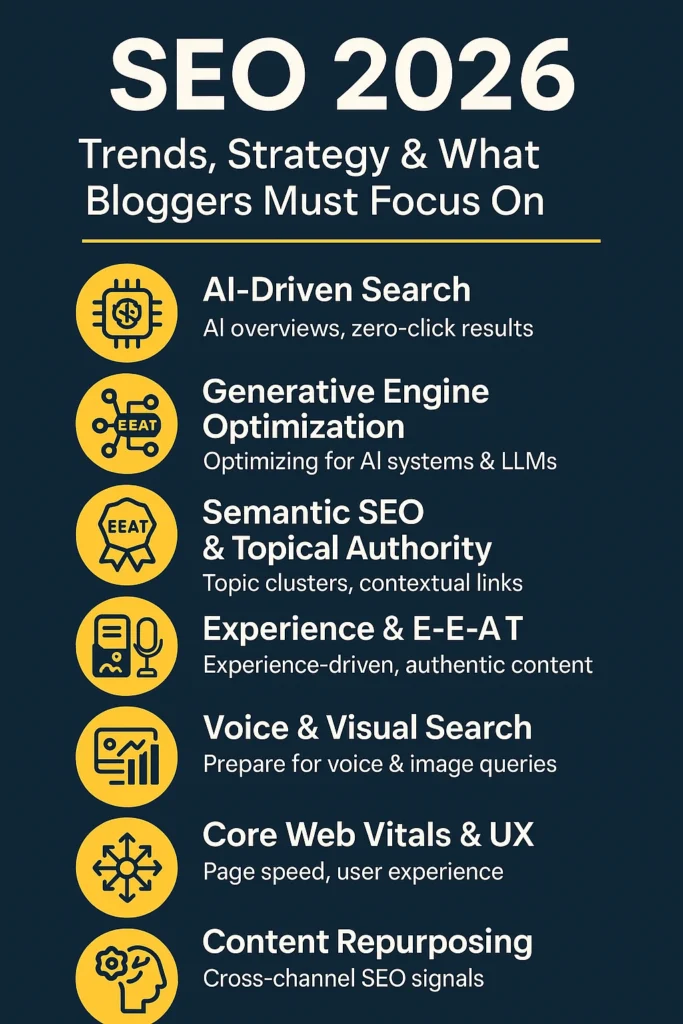
The world of SEO in 2026 looks radically different from what it was just two years ago. Search engines are no longer simple databases that index keywords — they’ve evolved into AI-powered reasoning systems that understand context, meaning, and user intent at a near-human level.
For bloggers and marketers, this means one thing: ranking is no longer about gaming algorithms — it’s about creating holistic, human-centric experiences.
In this deep-dive guide, we’ll break down the 10 SEO trends redefining digital marketing in 2026, from Generative Engine Optimization (GEO) and semantic content strategy to AI-driven discovery and experience-first ranking signals.
Table of Contents
ToggleThe Evolution of SEO: Where We Stand in 2026
SEO used to be about keywords, backlinks, and on-page tweaks. Today, it’s a hybrid ecosystem powered by AI interpretation, user engagement, and authority verification.
SEO in 2026:
AI Search Assistants (like ChatGPT, Perplexity, and Google’s SGE) deliver instant, summarized answers.
Zero-click results dominate — users often get what they need directly in the search interface.
Topical expertise outweighs keyword density.
Google’s focus has shifted from ranking “optimized” content to ranking credible experts. This is where Experience and E-E-A-T principles come in (we’ll discuss these below).
So if you’re still writing generic “10 tips” blogs — it’s time to evolve.
Search Generative Experience (SGE) and AI Overviews
Google’s Search Generative Experience (SGE) is the biggest change in a decade. Instead of showing just blue links, Google now uses AI to generate an instant overview of the answer — often citing 2–5 trusted sources.
This creates a new challenge: even if your article ranks, your click-through rate (CTR) might drop.
But there’s an opportunity here too. If your blog post is clear, structured, and data-rich, it can be quoted directly by SGE — placing your brand inside Google’s AI overview box.
How to Optimize for SGE:
Use question-based headings (e.g., “How does SEO work in 2026?”).
Provide concise, factual summaries early in each section.
Use structured data (FAQ schema, HowTo schema).
Write trustworthy content that other sources link to.
The new SEO is about being referenced — not just being ranked.
Generative Engine Optimization (GEO): The Next Frontier
GEO, short for Generative Engine Optimization, is the art of making your content discoverable by AI-driven engines (like ChatGPT, Bing Copilot, or Perplexity).
Traditional SEO optimized for search engines; GEO optimizes for language models.
How to Master GEO:
Use natural, conversational phrasing — the same way people ask AI questions.
Include context-rich, cited information (AI systems prefer content with external validation).
Avoid keyword stuffing — focus on semantic depth instead.
Embed clear author bios and credibility markers.
By 2026, GEO optimization is becoming as essential as traditional SEO. It ensures your blog is quoted by AI assistants when users ask related questions.
Semantic SEO and Topical Authority
Keywords are only the surface — entities and context are the real SEO currency in 2026.
Semantic SEO means structuring your site around topics, not individual phrases. For example, if your blog is about “sustainable fashion,” you might create a topic cluster like this:
| Pillar Content | Supporting Articles |
|---|---|
| Sustainable Fashion Guide | How to Recycle Clothes • Ethical Brands 2026 • Eco Fabrics Explained • Fast Fashion Alternatives |
Search engines now evaluate how deeply you cover a topic, how pages link internally, and whether users stay engaged.
This is how you build Topical Authority — and once Google trusts you for one niche, your entire site benefits.
Experience + E-E-A-T: The Trust Revolution
E-E-A-T — Experience, Expertise, Authority, Trustworthiness — has gone from a guideline to a ranking system.
In 2026, Google and AI engines actively seek proof of firsthand experience. That means:
Sharing personal data, results, or stories in your content.
Showing real author credentials (LinkedIn, About pages, citations).
Using first-person insights (“In my experience…”).
The more human, credible, and transparent your content appears, the more likely it is to earn top-tier rankings.
Voice, Visual, and Multimodal Search Optimization
Search is no longer just text-based.
In 2026, voice and visual queries are exploding — especially on mobile and AR devices.
Optimize by:
Adding alt text and descriptive captions for images.
Using natural speech patterns in your writing (“What’s the best…”).
Creating short-form summaries that AI or voice assistants can quote.
Being ready for multimodal search means your content appears across voice, video, and visual contexts — not just SERPs.
Core Web Vitals 3.0 and UX SEO
Google’s Core Web Vitals 3.0 update, rolled out in early 2026, now measures interaction quality and user delight.
The key metrics include:
INP (Interaction to Next Paint) — how fast your site responds to user input.
CLS (Cumulative Layout Shift) — visual stability.
FID replaced by INP for better interactivity measurement.
Good UX isn’t optional — it’s SEO-critical. A beautiful, fast, mobile-friendly site directly improves ranking potential.
Content Repurposing & Cross-Channel SEO Signals
Search engines increasingly evaluate multi-platform signals — engagement across YouTube, social, and even newsletters can improve trust scores.
By repurposing your blog posts into videos, carousels, and podcasts, you amplify authority and user reach.
Each touchpoint sends secondary SEO signals that reinforce your credibility as a niche leader.
AI Tools for Smarter SEO
AI is now the SEO assistant every blogger needs.
Top tools in 2026:
SurferSEO AI – for intent-based keyword mapping
NeuronWriter – semantic entity clustering
Frase.io – automated content briefs
Ahrefs / SEMrush NextGen – voice and AI search tracking
ChatGPT Plugins – real-time SERP analysis and outline generation
The future of SEO isn’t replacing humans — it’s augmenting human expertise with AI efficiency.
Future-Proofing Your Blog’s SEO Strategy
Algorithms will continue to evolve — but authentic authority never goes out of style.
To stay future-proof:
Focus on topic mastery, not one-off posts.
Build email lists and owned platforms beyond Google.
Update content quarterly with new data.
Prioritize reader experience over keyword games.
SEO in 2026 rewards creators who think like educators, not marketers.
FAQs: SEO 2026
1. Is SEO still relevant in 2026?
Absolutely. SEO is evolving, not dying. The focus has shifted from keyword density to content authority, experience, and AI discoverability.
2. What’s the biggest SEO trend in 2026?
Generative Engine Optimization (GEO) — optimizing content to be cited by AI models like ChatGPT and Perplexity.
3. How do I appear in Google’s AI overviews?
Structure your content with clear answers, schema markup, and factual authority.
4. Do backlinks still matter?
Yes, but contextual backlinks from trusted, niche sites matter more than raw volume.
5. Should I still use keywords?
Yes — but focus on topics, entities, and semantic relationships, not just word counts.
6. How often should I update content?
Every 3–6 months. Freshness and accuracy are ranking factors in 2026.


